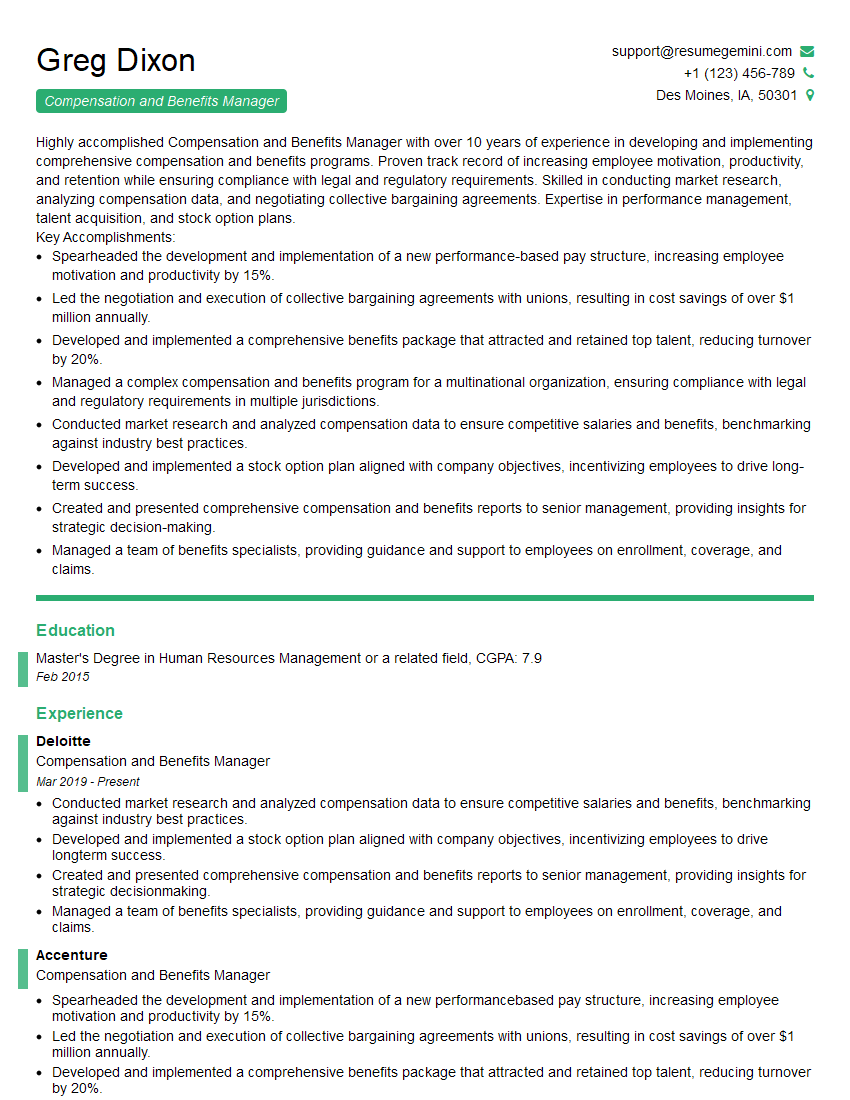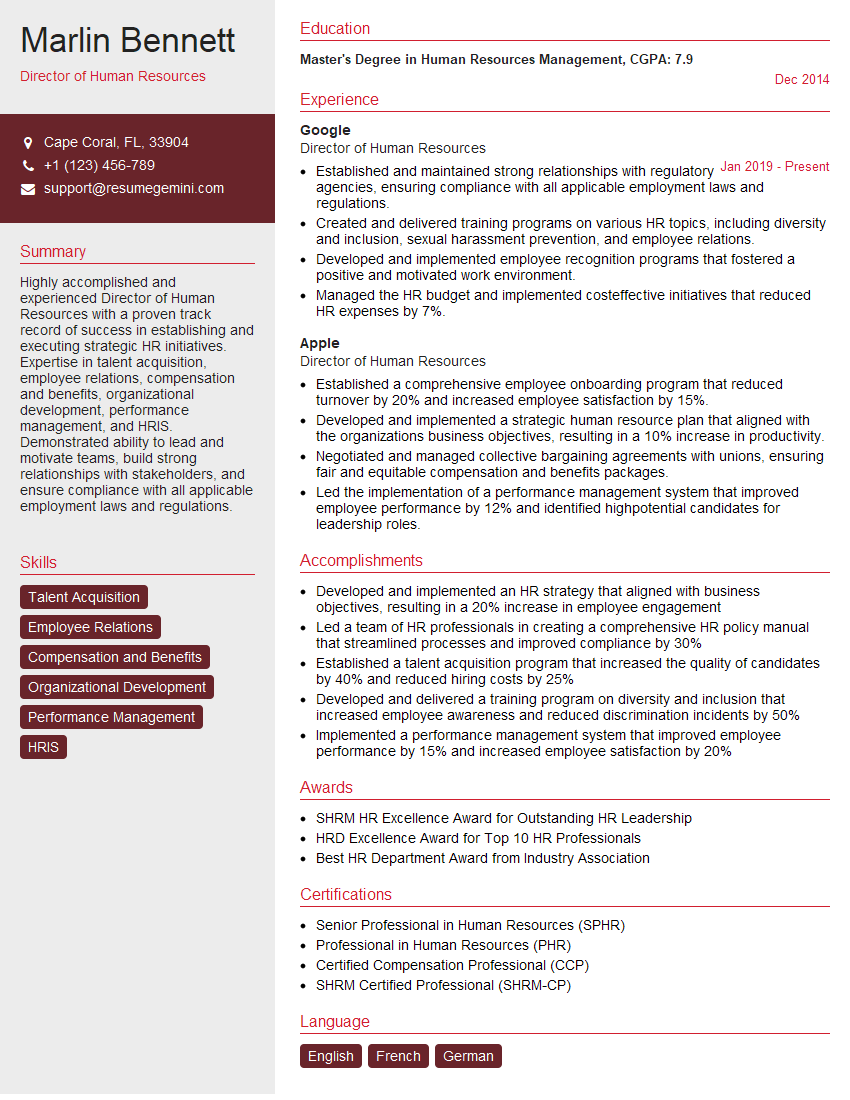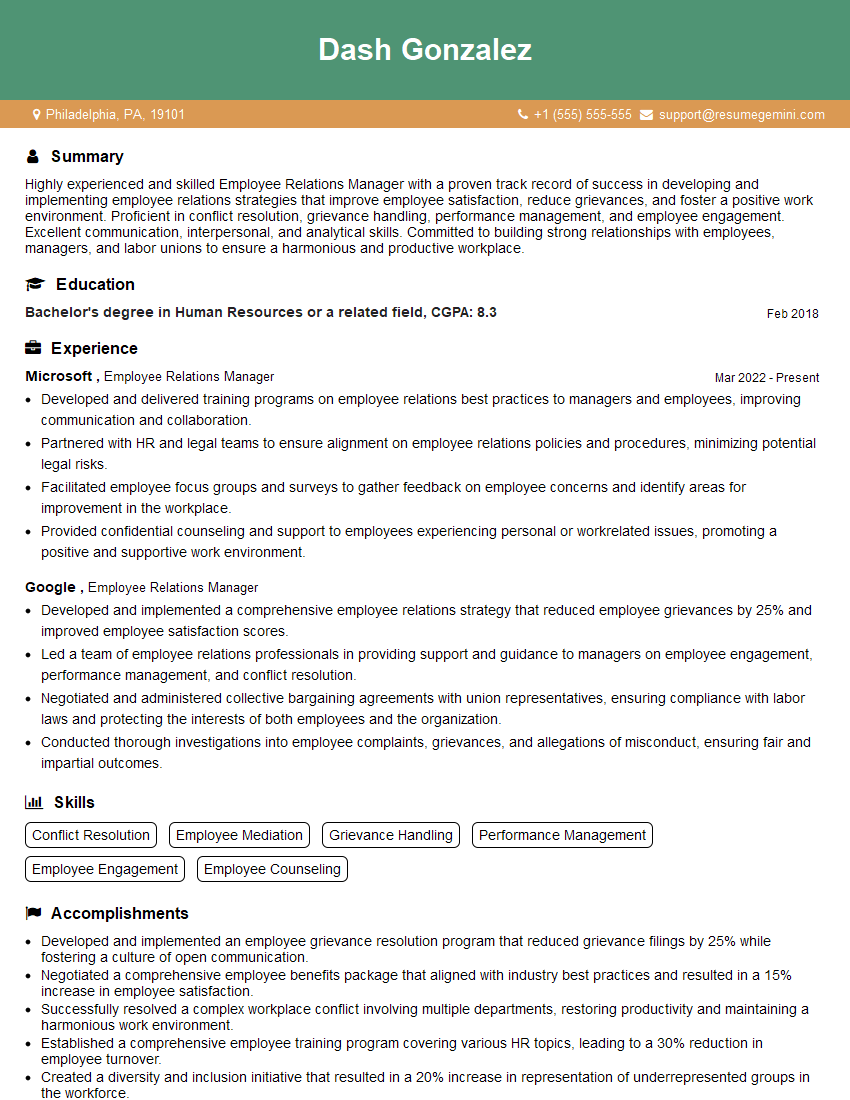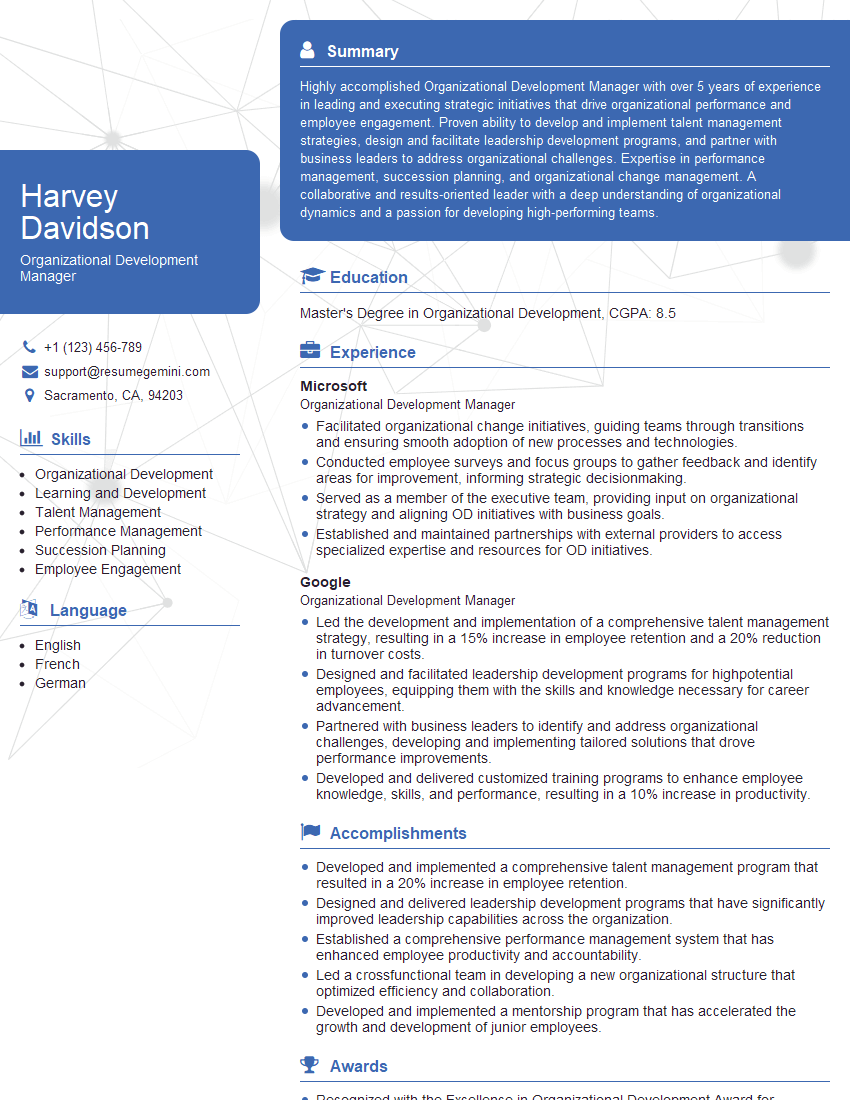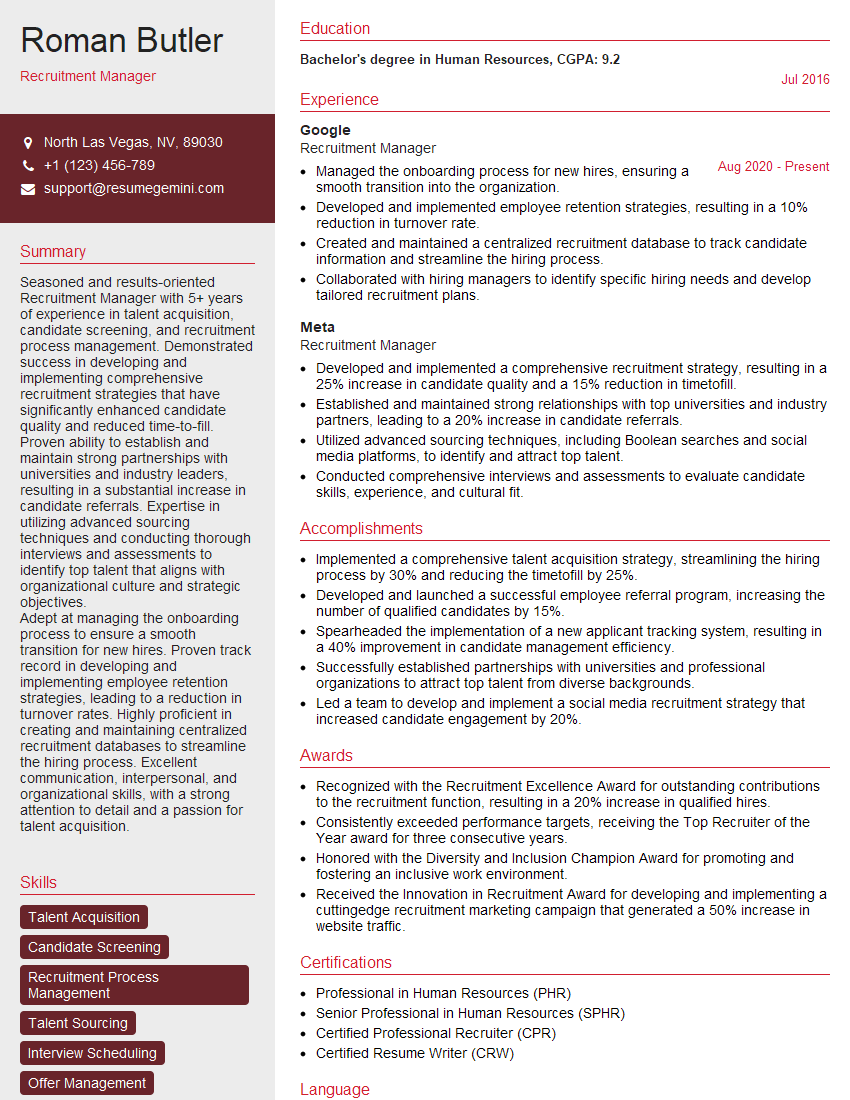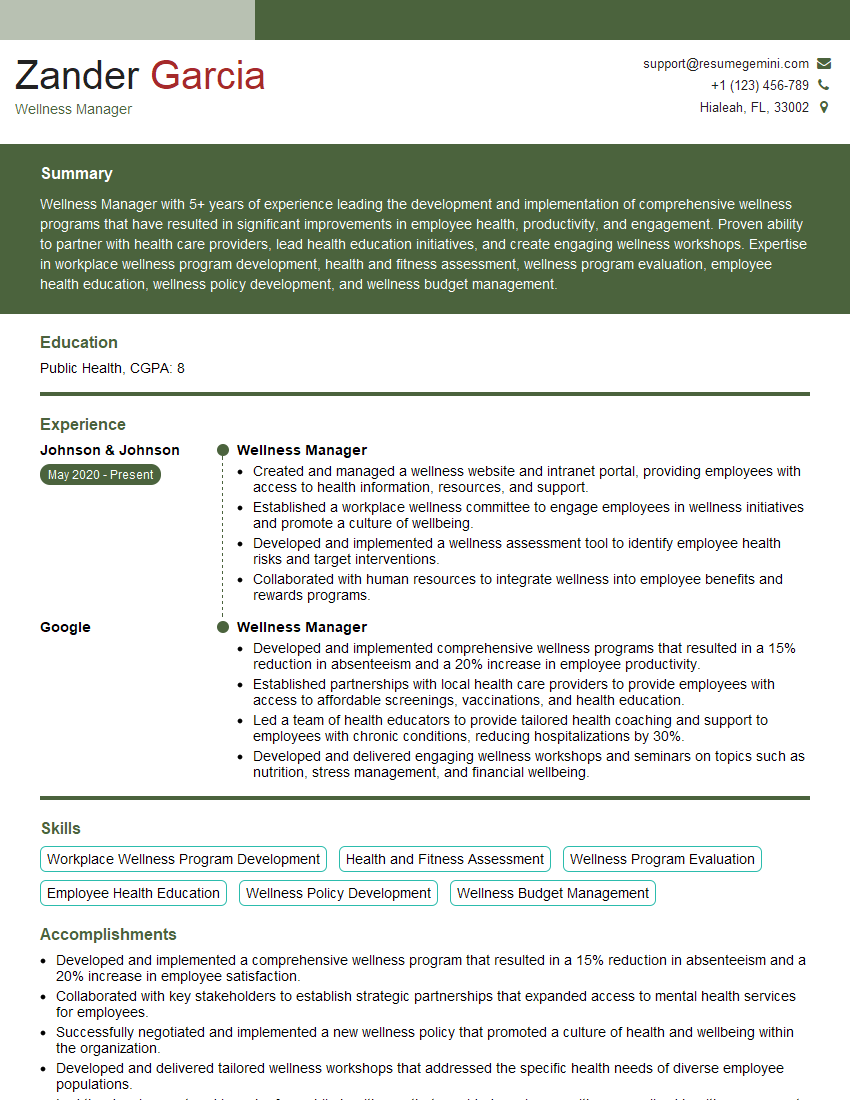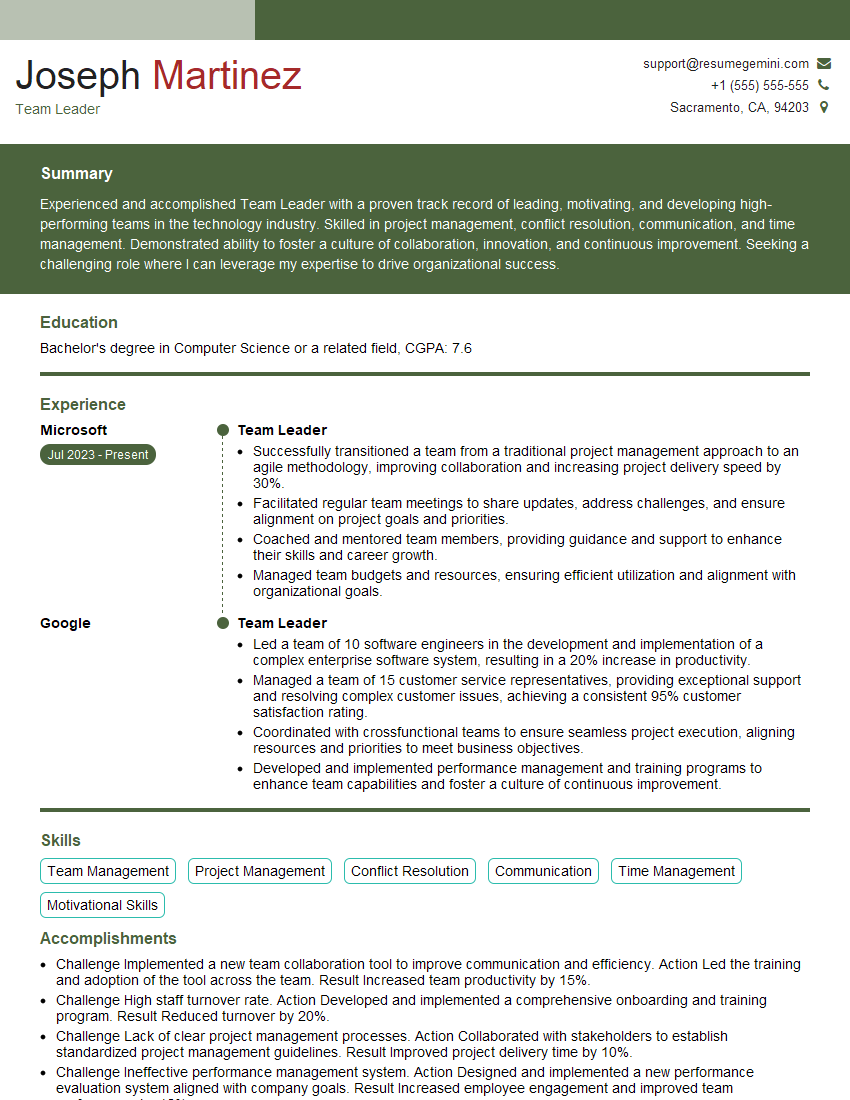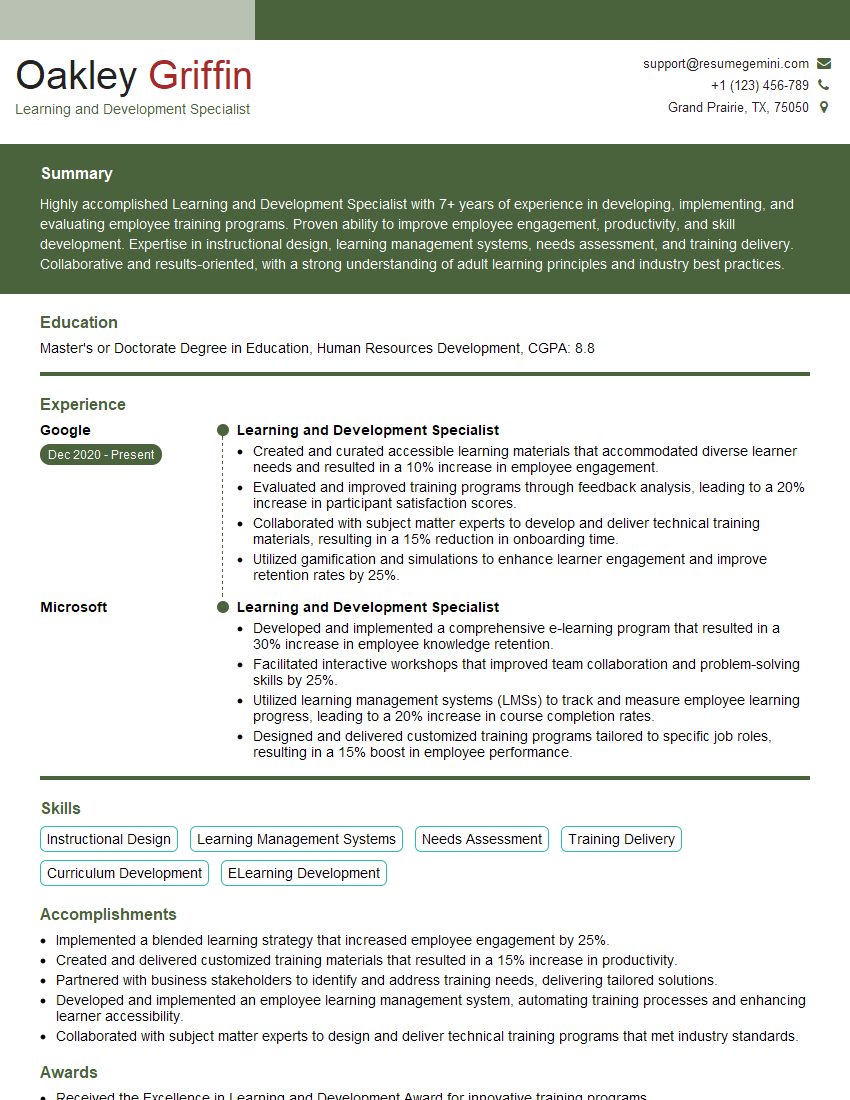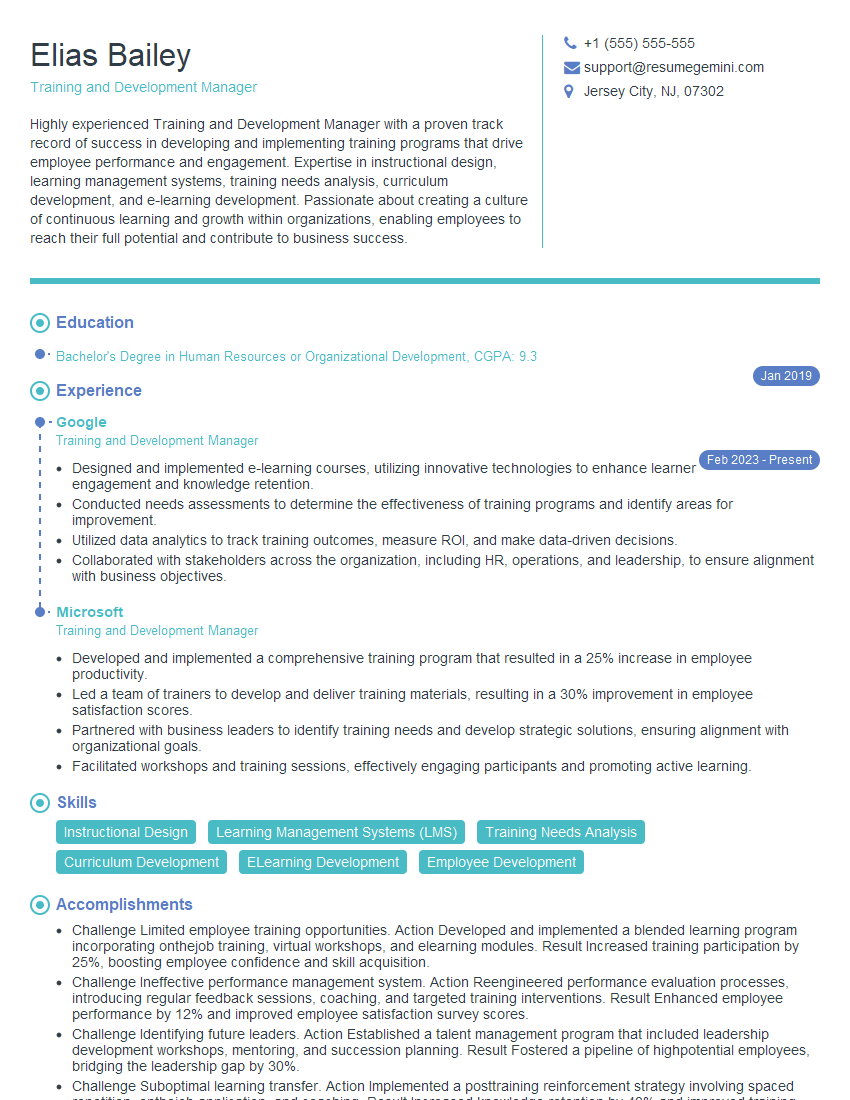Every successful interview starts with knowing what to expect. In this blog, we’ll take you through the top Management of Human Element interview questions, breaking them down with expert tips to help you deliver impactful answers. Step into your next interview fully prepared and ready to succeed.
Questions Asked in Management of Human Element Interview
Q 1. Describe your experience implementing a new employee onboarding program.
Implementing a new employee onboarding program requires a strategic approach that goes beyond simple paperwork. It’s about creating a positive first impression and setting the stage for a successful and engaged employee journey. In my previous role, we redesigned our onboarding process focusing on three key areas: pre-boarding, initial orientation, and ongoing integration.
Pre-boarding: We initiated contact with new hires before their start date, sending a welcome package with company information and a personalized message from their manager. This fostered excitement and helped them feel valued from day one. We also scheduled a pre-boarding call to answer questions and address any concerns.
Initial Orientation: The first day wasn’t just about paperwork. We created a structured program that included introductions to the team, a tour of the facilities, a clear explanation of company culture and values, and a hands-on introduction to their immediate role and responsibilities. We prioritized establishing a sense of belonging and community.
Ongoing Integration: We moved away from a one-size-fits-all approach. Instead, we created a 90-day plan with milestones, regular check-ins with their manager, and opportunities for mentorship and skill development. This ensured continuous support and helped new hires feel connected and empowered.
The result? We saw a significant increase in new hire retention and a marked improvement in employee satisfaction scores within the first six months. We measured success through surveys, exit interviews, and tracking key metrics like time-to-productivity.
Q 2. How would you address high employee turnover in a specific department?
Addressing high employee turnover requires a systematic investigation to identify the root causes. It’s rarely a single issue but often a combination of factors. My approach would involve a multi-pronged strategy:
Data Analysis: I’d start by analyzing exit interview data, employee satisfaction surveys, and performance reviews from the department experiencing high turnover. This helps identify recurring themes and pinpoint potential areas of concern such as compensation, management style, workload, or lack of growth opportunities.
Focus Groups & Interviews: Conducting focus groups and individual interviews with current employees in that department would provide valuable qualitative data and perspectives that surveys might miss. This allows for a deeper understanding of the work environment and employee sentiments.
Targeted Solutions: Based on the data analysis and qualitative feedback, I would develop targeted interventions. This might involve adjustments to compensation and benefits, leadership training for managers, improved work-life balance initiatives, increased opportunities for professional development, or even restructuring workflows to alleviate excessive workload.
Regular Monitoring: Finally, I would implement ongoing monitoring and evaluation to assess the effectiveness of the implemented solutions. This involves tracking key metrics such as turnover rates, employee satisfaction scores, and productivity levels. Adjustments would be made as needed based on the ongoing assessment.
For example, if the data reveals that a lack of career progression is a key driver of turnover, I would work with the department to develop clear career paths and provide employees with opportunities for skill development and advancement. If poor management is identified, I would invest in leadership training programs to improve managerial skills and create a more supportive work environment.
Q 3. Explain your approach to performance management and employee feedback.
My approach to performance management emphasizes continuous feedback, open communication, and a focus on development. I believe that performance management is not just an annual event but an ongoing process. It’s a partnership between the manager and the employee, focused on achieving both individual and organizational goals.
Regular Check-ins: Instead of solely relying on annual reviews, I advocate for regular one-on-one meetings between managers and employees to discuss progress, address challenges, and provide ongoing feedback. These check-ins provide opportunities for immediate course correction.
Goal Setting: Setting clear, measurable, achievable, relevant, and time-bound (SMART) goals is crucial. This ensures that both the employee and the manager are aligned on expectations and performance metrics.
360-degree Feedback: Where appropriate, I leverage 360-degree feedback to provide a comprehensive view of an employee’s performance. This helps identify blind spots and ensures a more holistic assessment.
Focus on Development: Performance reviews should not just focus on past performance but also on future development. Identifying areas for improvement and providing opportunities for training and growth is a critical component of effective performance management.
For example, rather than simply stating ‘your performance needs improvement,’ I would provide specific examples of areas where improvement is needed, outlining clear steps for development and offering support and resources to help the employee achieve their goals.
Q 4. What strategies have you used to improve employee engagement and morale?
Improving employee engagement and morale requires a holistic approach that addresses both individual needs and the overall work environment. My strategies typically include:
Recognition and Rewards: Implementing a robust system for recognizing and rewarding employee contributions, both big and small, is crucial. This can be through formal programs like employee of the month or informal methods like verbal praise and public acknowledgment.
Opportunities for Growth: Providing opportunities for professional development, skill enhancement, and career advancement boosts engagement. This could involve offering training programs, mentorship opportunities, or challenging assignments.
Empowerment and Autonomy: Empowering employees by giving them ownership over their work and decision-making processes increases engagement and job satisfaction. This demonstrates trust and respect for their capabilities.
Foster a Positive Work Environment: Cultivating a culture of open communication, collaboration, and mutual respect is essential. This includes creating opportunities for team building and social interaction.
Work-Life Balance Initiatives: Offering flexible work arrangements, generous paid time off, and other work-life balance initiatives can significantly improve morale and reduce stress.
For instance, in a previous role, we implemented a peer-to-peer recognition program where employees could nominate colleagues for outstanding work. This fostered a culture of appreciation and significantly improved team morale.
Q 5. How do you handle conflict resolution within a team?
Conflict resolution requires a fair, impartial, and timely approach that focuses on finding mutually acceptable solutions. My approach typically follows these steps:
Active Listening: The first step is to create a safe space for all parties involved to express their perspectives without interruption. Active listening is key to understanding the root causes of the conflict.
Identify the Issue: Clearly define the issue at hand, separating emotions from facts. This helps clarify the core problem and avoids getting bogged down in personal attacks.
Brainstorm Solutions: Collaboratively brainstorm potential solutions that address the concerns of all parties involved. Focus on finding win-win outcomes whenever possible.
Agree on a Solution: Once a mutually acceptable solution is identified, document it clearly and ensure all parties understand their roles and responsibilities in implementing it.
Follow-up: Regular follow-up is essential to monitor the effectiveness of the implemented solution and address any remaining concerns.
I often use mediation techniques to guide the process and ensure a fair and equitable resolution. The goal is not necessarily to determine who is right or wrong, but to find a solution that allows the team to move forward and work effectively together. For example, in a team conflict involving differing project approaches, I would facilitate a discussion to understand each team member’s perspective and collaboratively develop a hybrid approach that incorporates the strengths of each method.
Q 6. Describe your experience with change management initiatives.
Successful change management requires a structured approach that addresses the human element of change. My experience involves using a combination of models and techniques, often adapting them to the specific context of the change initiative. I usually follow a phased approach:
Assess & Plan: Begin by thoroughly assessing the need for change, identifying stakeholders, understanding their concerns, and developing a detailed plan that outlines the goals, timelines, and resources required. This includes anticipating potential resistance to change.
Communicate & Engage: Transparency and open communication are crucial. Communicate the reasons for change, the impact on employees, and the plan for implementation clearly and frequently. Involve employees in the process to gain buy-in and reduce resistance.
Implement & Support: Execute the plan systematically, providing necessary training and support to employees. Monitor progress closely and address any issues that arise proactively.
Evaluate & Refine: After implementation, evaluate the effectiveness of the change initiative and make adjustments as needed. Continuous monitoring and refinement are essential to ensure the long-term success of the change.
For instance, when implementing a new CRM system, I would ensure that employees were trained thoroughly, provided with adequate support, and given opportunities to provide feedback throughout the process. This approach minimized disruption and ensured a smooth transition.
Q 7. How do you measure the success of HR programs and initiatives?
Measuring the success of HR programs and initiatives requires a multifaceted approach that goes beyond simple anecdotal evidence. I typically utilize a combination of quantitative and qualitative data to assess impact:
Quantitative Metrics: These include measurable data points like employee turnover rates, employee satisfaction scores (through surveys), time-to-fill for open positions, training completion rates, performance metrics linked to specific initiatives, and cost-per-hire.
Qualitative Data: This involves gathering feedback through focus groups, interviews, observation, and analysis of employee comments and suggestions. This provides valuable insights into employee perceptions and the overall impact of the program.
Benchmarking: Comparing the results of our initiatives against industry benchmarks and best practices helps to assess our performance relative to other organizations and identify areas for improvement.
Return on Investment (ROI): Where possible, I calculate the return on investment for HR programs and initiatives. This involves evaluating the costs associated with the program and comparing them to the benefits gained, such as increased productivity, reduced turnover, or improved employee engagement.
For example, if we implement a new leadership training program, we would measure its success by tracking changes in employee satisfaction scores, leadership effectiveness ratings, and the reduction in employee turnover within the teams that participated in the training. We would also collect qualitative feedback through surveys and interviews to understand the employees’ perceptions of the program’s effectiveness.
Q 8. Explain your understanding of different compensation and benefits strategies.
Compensation and benefits strategies are crucial for attracting, retaining, and motivating employees. They go beyond just salary and encompass a holistic approach to rewarding and supporting the workforce. Different strategies cater to various organizational goals and employee needs.
- Competitive Pay Structures: This involves benchmarking salaries against industry standards and competitors to ensure fair and attractive compensation. For example, a tech company might offer higher salaries than a non-profit organization to attract top talent.
- Performance-Based Pay: This links compensation directly to individual or team performance, often through bonuses, commissions, or profit-sharing. A sales team might receive a commission based on their sales targets, motivating them to exceed expectations.
- Benefits Packages: Comprehensive benefits packages significantly enhance employee well-being and attraction. Common benefits include health insurance, retirement plans (401k, pension), paid time off (PTO), life insurance, and disability insurance. Some companies offer additional perks like childcare assistance, wellness programs, or tuition reimbursement.
- Total Rewards Strategy: This broader approach considers all aspects that contribute to an employee’s overall value proposition, including compensation, benefits, recognition, development opportunities, and work-life balance. It aims to create a holistic package that’s highly attractive to candidates.
- Flexible Compensation Plans: These allow employees to customize their benefits based on their individual needs, such as choosing between different health insurance plans or contributing more to retirement savings.
Choosing the right strategy depends on factors such as industry, company size, financial resources, and organizational culture. For instance, a startup might focus on equity and growth opportunities, while a large corporation might prioritize a robust benefits package.
Q 9. How do you ensure compliance with relevant employment laws and regulations?
Compliance with employment laws and regulations is paramount. Non-compliance can result in significant legal penalties, reputational damage, and employee relations issues. My approach involves a multi-faceted strategy:
- Regular Training and Updates: I ensure all HR personnel receive ongoing training on current employment laws, including those related to wages, hours, discrimination, harassment, safety, and data privacy (e.g., GDPR, CCPA).
- Policy Development and Review: We develop comprehensive HR policies that reflect current legislation and best practices. These policies are regularly reviewed and updated to ensure compliance. This includes handbooks for employees and managers, outlining company expectations and procedures.
- Audits and Self-Assessments: Regular audits and self-assessments help identify potential compliance gaps. We utilize checklists and assessments to systematically review our practices.
- Collaboration with Legal Counsel: I work closely with legal counsel to address any compliance concerns and ensure we’re consistently adhering to the law. This is especially important when dealing with complex employment matters or changes in legislation.
- Record Keeping and Documentation: Maintaining accurate and detailed records of all employment-related activities is essential. This ensures we can readily provide proof of compliance during audits or legal proceedings.
For example, ensuring compliance with the Fair Labor Standards Act (FLSA) requires careful tracking of employee hours, overtime pay, and minimum wage regulations. Similarly, maintaining compliance with anti-discrimination laws necessitates thorough investigation and remediation of any reported instances of harassment or discrimination.
Q 10. Describe your experience with talent acquisition and recruitment processes.
My experience in talent acquisition and recruitment involves a data-driven approach focused on attracting top talent. It includes:
- Needs Assessment: Collaborating with hiring managers to clearly define the job requirements, necessary skills, and cultural fit.
- Strategic Sourcing: Utilizing various channels to attract candidates, including job boards, social media, networking, employee referrals, and university partnerships. I leverage applicant tracking systems (ATS) to streamline the process.
- Candidate Screening and Selection: Employing effective screening methods, such as resume screening, phone interviews, skills assessments, and behavioral interviews, to identify the most qualified candidates. I utilize structured interviews to ensure fair and consistent evaluation.
- Offer and Onboarding: Extending competitive offers and developing a comprehensive onboarding program to integrate new hires seamlessly into the organization. This involves clear expectations, introductions, and training.
- Employer Branding: Building a strong employer brand to attract and retain talent, focusing on the company culture, values, and opportunities for growth. This includes leveraging company reviews and testimonials.
For example, during a recent recruitment for a software engineering role, we used a combination of LinkedIn recruitment, tech-focused job boards, and employee referrals. We also implemented a technical coding assessment to evaluate candidates’ skills before moving to in-person interviews. This approach helped us identify and hire a highly qualified candidate within a short timeframe.
Q 11. What is your approach to developing employee training and development programs?
Developing employee training and development programs requires a systematic approach that aligns with organizational goals and individual needs. My approach focuses on several key elements:
- Needs Analysis: Conducting thorough assessments to identify skill gaps, performance deficiencies, and future training needs. This involves gathering data through surveys, performance reviews, and interviews.
- Learning Objectives: Defining clear and measurable learning objectives for each training program. These objectives ensure that participants gain the necessary skills and knowledge.
- Program Design: Developing engaging and effective training programs using various methods, such as online courses, workshops, mentoring, on-the-job training, and simulations. I consider different learning styles and preferences.
- Program Delivery: Implementing the training programs effectively, ensuring accessibility and providing necessary resources. This could involve both in-person and online delivery methods.
- Evaluation and Feedback: Evaluating the effectiveness of training programs through various methods, including pre- and post-training assessments, feedback surveys, and performance evaluations. The feedback helps refine future programs.
For example, I once designed a leadership development program for mid-level managers. This program included workshops on communication, conflict resolution, and strategic planning, coupled with individual coaching and mentoring. Post-training evaluations showed significant improvements in leadership skills and performance.
Q 12. How would you identify and address skills gaps within an organization?
Identifying and addressing skills gaps is crucial for organizational success. My approach involves a multi-step process:
- Performance Reviews and Feedback: Analyzing performance reviews and employee feedback to identify areas where individuals or teams lack essential skills.
- Skills Gap Analysis: Conducting a systematic analysis to determine the extent and impact of skills gaps across the organization. This might involve surveys, interviews, and observation of work processes.
- Job Analysis and Competency Modeling: Reviewing job descriptions and competency models to identify required skills and compare them to existing employee skills.
- Training and Development Initiatives: Developing and implementing training programs to address identified skills gaps. This might include internal training, external courses, or mentorship programs.
- Recruitment and External Hiring: If internal training is not sufficient, recruiting and hiring individuals with the necessary skills can be necessary.
- Succession Planning: Implementing a succession plan to identify and develop high-potential employees to fill future leadership roles and address potential skills shortages in advance.
For instance, if a skills gap analysis reveals a lack of data analytics skills within a marketing team, the organization could implement training programs, hire a data analyst, or both to close the gap.
Q 13. How do you foster a positive and inclusive work environment?
Fostering a positive and inclusive work environment is essential for employee well-being, productivity, and retention. My approach focuses on:
- Open Communication: Establishing open and transparent communication channels where employees feel comfortable sharing their ideas, concerns, and feedback. This includes regular team meetings, employee surveys, and opportunities for informal communication.
- Respectful Workplace Culture: Promoting a culture of respect, empathy, and understanding where all employees feel valued and appreciated. This requires clear policies against harassment and discrimination and robust mechanisms for reporting and addressing grievances.
- Work-Life Balance: Supporting employees in achieving a healthy work-life balance through flexible work arrangements, generous paid time off, and wellness programs. This fosters a supportive environment that prioritizes both work and personal well-being.
- Recognition and Rewards: Recognizing and rewarding employees’ contributions and achievements to build morale and foster a sense of appreciation. This includes both formal awards and informal recognition of excellent work.
- Team Building and Social Events: Organizing team-building activities and social events to encourage collaboration, build relationships, and promote a sense of community.
For example, creating employee resource groups (ERGs) can provide a sense of belonging for employees from underrepresented groups and foster a more inclusive environment.
Q 14. Describe your experience with diversity and inclusion initiatives.
My experience with diversity and inclusion initiatives involves a holistic and strategic approach. It encompasses:
- Inclusive Recruitment Practices: Implementing strategies to attract and recruit candidates from diverse backgrounds, including targeted outreach, blind resume screening, and diverse interview panels.
- Diversity Training: Providing comprehensive diversity and inclusion training to all employees to raise awareness of unconscious bias, promote cultural sensitivity, and build inclusive leadership skills.
- Mentorship and Sponsorship Programs: Creating mentorship and sponsorship programs to support the career development of employees from underrepresented groups and provide access to leadership networks.
- Data Collection and Analysis: Tracking diversity metrics to assess progress and identify areas for improvement. This allows for evidence-based decision-making in advancing diversity and inclusion goals.
- Employee Resource Groups (ERGs): Supporting and empowering employee resource groups that promote inclusivity and provide a platform for employees from diverse backgrounds to connect and share their experiences.
- Accessible Workplace: Ensuring the workplace is accessible to all employees, including those with disabilities, through appropriate accommodations and adjustments.
For example, I worked on an initiative to increase the representation of women in leadership positions. This involved creating a leadership development program specifically targeted towards women, coupled with mentorship opportunities and sponsorship by senior leaders. The result was a noticeable increase in women in management roles.
Q 15. Explain your approach to managing employee performance issues.
Managing employee performance issues requires a proactive, supportive, and documented approach. It’s not about punishment, but about improvement and helping the employee succeed. My approach involves several key steps:
- Early Identification: Regular check-ins, performance reviews, and observation are crucial to identify issues early. This allows for timely intervention before problems escalate.
- Documentation: All performance-related conversations, including positive feedback and concerns, must be meticulously documented. This protects both the employee and the organization.
- Performance Improvement Plan (PIP): If performance is consistently below expectations, a PIP is developed collaboratively with the employee. This plan clearly outlines specific, measurable, achievable, relevant, and time-bound (SMART) goals, along with the support and resources needed to achieve them.
- Regular Monitoring and Support: The employee’s progress is monitored closely, providing ongoing support and feedback. Regular meetings are held to review progress and address any obstacles.
- Consequences: If, despite support and a PIP, performance doesn’t improve, progressive disciplinary actions may be necessary, always following company policy and legal requirements. This might involve warnings, suspension, or ultimately, termination.
For example, in a previous role, I worked with an employee whose sales figures were consistently below target. Instead of immediate reprimand, we collaboratively identified the root cause – a lack of confidence in closing deals. We implemented a PIP focusing on sales training, coaching, and shadowing successful colleagues. With support and clear goals, the employee’s performance significantly improved.
Career Expert Tips:
- Ace those interviews! Prepare effectively by reviewing the Top 50 Most Common Interview Questions on ResumeGemini.
- Navigate your job search with confidence! Explore a wide range of Career Tips on ResumeGemini. Learn about common challenges and recommendations to overcome them.
- Craft the perfect resume! Master the Art of Resume Writing with ResumeGemini’s guide. Showcase your unique qualifications and achievements effectively.
- Don’t miss out on holiday savings! Build your dream resume with ResumeGemini’s ATS optimized templates.
Q 16. How do you utilize data analytics to inform HR decisions?
Data analytics plays a vital role in evidence-based HR decision-making. I leverage data to gain insights into various aspects of the workforce, including:
- Recruitment Effectiveness: Analyzing time-to-hire, cost-per-hire, and source-of-hire data to optimize recruitment strategies.
- Employee Turnover: Identifying patterns and drivers of employee attrition through analysis of exit interviews, tenure data, and performance reviews, allowing for proactive interventions.
- Compensation and Benefits: Analyzing salary data, benefit utilization, and employee satisfaction surveys to ensure competitive and effective compensation and benefits packages.
- Training and Development: Evaluating the impact of training programs on employee performance and identifying areas for improvement.
- Performance Management: Analyzing performance data to identify high-performers, areas for improvement, and potential skill gaps.
For instance, by analyzing employee turnover data, I discovered a high attrition rate among new hires in a specific department. Further investigation revealed a lack of onboarding support and unclear role expectations. Implementing a revised onboarding program significantly reduced turnover in that department.
Q 17. Describe your experience with employee surveys and feedback mechanisms.
Employee surveys and feedback mechanisms are essential for understanding employee sentiment, identifying areas for improvement, and fostering a culture of open communication. My experience includes designing, implementing, and analyzing various feedback mechanisms such as:
- Annual Employee Satisfaction Surveys: These provide a comprehensive overview of employee opinions on various aspects of the workplace, including compensation, benefits, work-life balance, and management.
- Pulse Surveys: Shorter, more frequent surveys used to gauge employee sentiment on specific issues or initiatives.
- 360-degree Feedback: Collecting feedback from multiple sources, including supervisors, peers, and subordinates, to provide a holistic view of an employee’s performance and development areas.
- Focus Groups: In-depth discussions with small groups of employees to gather qualitative data and explore specific issues in more detail.
- Open-door policies and suggestion boxes: Encouraging informal feedback through readily accessible channels.
In a previous role, we implemented an anonymous employee survey that revealed concerns about workload and communication. This feedback led to the implementation of new project management tools and improved communication strategies, resulting in increased employee satisfaction and productivity.
Q 18. How would you develop a succession plan for key positions within an organization?
Developing a robust succession plan is crucial for organizational stability and continuity. My approach involves:
- Identifying Key Positions: Begin by identifying critical roles essential for the organization’s success.
- Assessing Talent: Evaluate current employees’ skills, experience, and potential for advancement. Use tools like performance reviews, 360-degree feedback, and skills assessments.
- Developing High-Potential Employees: Identify high-potential individuals and provide them with tailored development opportunities, including mentorship, training, and challenging assignments.
- Creating Development Plans: Develop individual development plans for high-potential employees, outlining specific goals, timelines, and resources needed for succession.
- Monitoring Progress: Regularly track the progress of high-potential employees and adjust development plans as needed.
- Building a Talent Pipeline: Recruiting and developing external candidates to supplement internal talent.
- Documentation and Communication: Maintain thorough documentation of the succession plan and communicate it to relevant stakeholders.
For example, I once helped develop a succession plan for a key leadership role by identifying three high-potential candidates. Each received a customized development plan focusing on specific leadership skills, including mentoring opportunities and participation in leadership training programs. This ensured a smooth transition when the position became vacant.
Q 19. Explain your understanding of different organizational structures and their impact on human capital.
Organizational structure significantly impacts human capital management. Different structures have varying strengths and weaknesses regarding employee engagement, communication, and decision-making. Here are some common structures and their impact:
- Hierarchical/Traditional: Clearly defined roles and reporting lines, but can lead to slow decision-making and limited employee empowerment.
- Flat/Decentralized: Fewer layers of management, promoting collaboration and quicker decision-making, but can lead to ambiguity in roles and responsibilities.
- Matrix: Employees report to multiple managers, fostering cross-functional collaboration, but can lead to role conflict and confusion.
- Network/Virtual: Employees work remotely and collaboratively across different locations, offering flexibility but requiring strong communication and technology infrastructure.
Understanding the organizational structure is crucial for tailoring HR practices. For example, in a hierarchical structure, clear communication channels and training programs emphasizing compliance are vital. In a flat organization, emphasis should be on empowering employees and fostering collaborative decision-making.
Q 20. How do you balance the needs of the business with the needs of employees?
Balancing business needs with employee needs is a core aspect of effective human capital management. It’s not a zero-sum game; both are interdependent. My approach involves:
- Open Communication: Fostering a culture of open and transparent communication where both business objectives and employee concerns are openly discussed.
- Employee Engagement Strategies: Implementing strategies that foster employee engagement, such as recognition programs, flexible work arrangements, and opportunities for professional development.
- Performance Management System: A well-designed performance management system that aligns individual goals with organizational objectives, ensuring that employees understand how their work contributes to the overall success of the business.
- Work-Life Balance Initiatives: Providing support for work-life balance through flexible work arrangements, generous leave policies, and wellness programs.
- Fair Compensation and Benefits: Offering competitive compensation and benefits packages that attract and retain top talent while aligning with the company’s financial resources.
For example, during a period of significant business restructuring, we ensured employees were kept informed throughout the process. We offered outplacement services to those whose roles were eliminated and transparently communicated the rationale behind the changes. This approach mitigated anxiety and fostered trust, despite the challenging circumstances.
Q 21. What is your experience with employee wellness programs?
Employee wellness programs are crucial for creating a healthy and productive workforce. My experience includes developing and implementing programs focused on:
- Physical Health: Offering gym memberships, health screenings, and wellness workshops focusing on nutrition and fitness.
- Mental Health: Providing access to employee assistance programs (EAPs), mental health resources, and stress management workshops.
- Financial Wellness: Offering workshops on financial planning, budgeting, and debt management.
- Work-Life Balance: Promoting work-life balance through flexible work arrangements, generous leave policies, and encouraging employees to take breaks.
In a previous role, we implemented a comprehensive wellness program that included on-site fitness classes, health screenings, and an EAP. This resulted in reduced absenteeism, improved employee morale, and a decrease in healthcare costs. A key to success was measuring the program’s effectiveness through tracking participation rates, employee feedback, and health-related data.
Q 22. How do you build strong relationships with employees at all levels of the organization?
Building strong relationships across all organizational levels requires a multi-faceted approach focusing on open communication, empathy, and consistent effort. It’s not just about ‘managing’ people but building genuine connections.
- Open Door Policy and Regular Communication: I foster an environment where employees feel comfortable approaching me with concerns or ideas. Regular team meetings, one-on-one check-ins, and department-wide updates ensure everyone stays informed and feels valued.
- Active Listening and Empathy: Truly hearing what employees have to say, understanding their perspectives, and validating their feelings is crucial. This shows respect and builds trust. For example, during a recent performance review, I took extra time to understand an employee’s frustrations with a new project, helping to alleviate their concerns and re-focus their efforts.
- Recognition and Appreciation: Publicly acknowledging achievements, both big and small, reinforces positive behaviors and boosts morale. This could be anything from a simple ‘thank you’ to a formal award or bonus.
- Mentorship and Development: Investing in employees’ growth through mentorship or providing opportunities for professional development shows that you care about their future within the organization. I’ve personally mentored junior team members, helping them navigate challenges and develop their skills.
- Fairness and Consistency: Treating all employees fairly and consistently, applying policies and procedures equitably, is vital for building trust and avoiding resentment.
Q 23. Describe your experience with negotiating contracts with vendors.
Negotiating contracts with vendors requires a strategic approach that balances the needs of the organization with the vendor’s capabilities and pricing. It’s about finding a win-win solution.
- Thorough Preparation: Before entering negotiations, I conduct thorough research on the vendor, their market rates, and competitor offerings. This ensures I have a strong understanding of the landscape and can make informed decisions.
- Clear Objectives and Scope Definition: I clearly define the organization’s needs and expectations, creating a detailed scope of work that leaves no room for ambiguity. This helps to prevent disputes later on.
- Collaborative Approach: I approach negotiations as a collaborative process, seeking mutually beneficial outcomes. Open communication and understanding the vendor’s constraints are key to finding common ground.
- Risk Management: I identify and mitigate potential risks associated with the contract, including payment terms, service level agreements (SLAs), and termination clauses. For instance, I always include provisions for performance reviews and potential penalties for missed deadlines.
- Legal Review: I ensure that the final contract is reviewed by legal counsel to ensure compliance with all applicable laws and regulations.
For example, in negotiating a contract for a new HRIS system, I successfully negotiated a lower initial price by leveraging our organization’s size and commitment to a long-term contract. Simultaneously, I ensured strong SLAs were in place to protect our business continuity.
Q 24. How do you ensure the confidentiality of employee information?
Maintaining the confidentiality of employee information is paramount and requires a multi-layered approach incorporating policies, training, and technology.
- Strict Policies and Procedures: We have comprehensive policies outlining access controls, data security measures, and procedures for handling sensitive employee data. These policies are communicated to all employees through mandatory training sessions.
- Access Control: Access to employee information is restricted to authorized personnel on a need-to-know basis. We use role-based access controls to ensure that only individuals with legitimate business reasons can access specific information.
- Data Encryption and Secure Storage: All employee data is encrypted both in transit and at rest, using robust security protocols. Data is stored in secure, controlled environments that comply with relevant regulations, such as GDPR or CCPA.
- Employee Training: Regular training sessions educate employees on data security best practices, emphasizing the importance of confidentiality and the consequences of data breaches. This includes training on phishing awareness, password security, and safe data handling procedures.
- Regular Audits and Compliance: We conduct regular audits to ensure compliance with data privacy regulations and identify potential vulnerabilities in our security systems. We also proactively respond to any identified security threats.
Q 25. How do you stay up-to-date on current trends and best practices in HR?
Staying current in HR requires a proactive and multi-pronged approach.
- Professional Development: I regularly attend HR conferences, webinars, and workshops to stay abreast of the latest trends and best practices. I also actively participate in professional organizations such as SHRM.
- Industry Publications and Research: I subscribe to industry publications like HR Magazine and Harvard Business Review and regularly read research reports from reputable organizations such as the Society for Human Resource Management (SHRM) and the World at Work.
- Networking: I maintain a strong network of contacts within the HR field, engaging in discussions and sharing information with colleagues and peers.
- Online Resources: I utilize online resources such as SHRM’s website and other reputable HR platforms to access information on current legislation, best practices, and emerging trends.
- Continuous Learning: I embrace a culture of continuous learning, always seeking opportunities to expand my knowledge and skills in areas such as talent management, compensation and benefits, and employee relations.
Q 26. Describe a time you had to make a difficult decision related to employee relations.
In a previous role, I had to make a difficult decision regarding an employee who consistently violated company policy despite repeated verbal and written warnings. This created a challenging situation because this employee was generally a strong performer but repeatedly demonstrated unprofessional behavior.
Following our established disciplinary process, and after consulting with senior management and legal counsel, I made the difficult decision to terminate the employee’s employment. This was not an easy decision as it impacted the employee and the team. However, maintaining a consistent application of company policy and ensuring a fair and equitable work environment for all employees was paramount. The decision was documented thoroughly, and I ensured the employee received the necessary support and resources during their transition.
This experience reinforced the importance of having clearly defined policies, consistently applying them, and documenting every step of the disciplinary process. It also highlighted the need to communicate openly and honestly with all parties involved, fostering transparency and understanding throughout the process.
Q 27. How would you address resistance to change within an organization?
Addressing resistance to change requires a thoughtful and empathetic approach that prioritizes communication, involvement, and addressing concerns.
- Open Communication and Transparency: Explain the reasons for the change, the benefits it will bring, and how it will impact employees. Address concerns and answer questions openly and honestly.
- Employee Involvement: Involve employees in the change process, seeking their input and feedback. This creates a sense of ownership and buy-in, reducing resistance.
- Address Concerns and Fears: Acknowledge and address employees’ concerns and fears about the change. This shows respect for their perspectives and helps to alleviate anxieties.
- Training and Support: Provide employees with the training and support they need to adapt to the changes. This can include training on new systems, processes, or skills.
- Recognize and Reward Early Adopters: Acknowledge and reward employees who embrace the change and help others to adapt. This creates positive momentum and encourages others to follow suit.
- Celebrate Successes: Celebrate successes along the way to build momentum and reinforce positive change.
For instance, when implementing a new performance management system, I organized a series of workshops and training sessions to guide employees through the changes. I actively sought feedback and addressed any concerns raised, building trust and ultimately securing successful adoption of the new system.
Q 28. Explain your experience with implementing a new HR technology system.
Implementing a new HR technology system requires meticulous planning, robust communication, and ongoing support.
- Needs Assessment and System Selection: The process begins with a thorough assessment of the organization’s needs and requirements. Then, we carefully evaluate different systems to find the best fit for our organization. This includes considering factors such as cost, functionality, integration capabilities, and user-friendliness.
- Project Planning and Management: A detailed project plan is essential, outlining timelines, milestones, responsibilities, and resources. This plan is regularly reviewed and updated to account for any changes or unexpected challenges.
- Data Migration and Integration: Migrating data from the old system to the new system is a critical step, requiring careful planning and execution to ensure data accuracy and integrity. This often includes testing and validation to confirm data integrity.
- Training and Support: Comprehensive training programs are crucial to ensure employees understand how to use the new system effectively. Ongoing support and technical assistance are provided to address any questions or issues.
- Change Management: A well-defined change management strategy is essential to minimize disruption and ensure smooth transition. This includes communication plans, stakeholder management, and feedback mechanisms.
- Post-Implementation Review: After the system is live, a thorough review is conducted to assess the effectiveness of the implementation, identify areas for improvement, and ensure the system meets the organization’s needs.
In a previous role, we successfully implemented a new HRIS system, resulting in improved efficiency, better data management, and enhanced reporting capabilities. Key to our success was robust training and ongoing support for employees. We also established a feedback mechanism allowing users to share their experiences, enabling us to make adjustments and improve the user experience.
Key Topics to Learn for Management of Human Element Interview
- Organizational Behavior: Understanding individual and group dynamics within the workplace; exploring theories like Maslow’s Hierarchy of Needs and its application in motivating employees.
- Leadership Styles and Theories: Analyzing different leadership approaches (transformational, transactional, servant leadership) and their effectiveness in various contexts; developing strategies for adapting your leadership style to diverse teams and situations.
- Talent Management and Development: Exploring strategies for attracting, retaining, and developing high-performing teams; discussing performance management systems, succession planning, and employee training initiatives.
- Communication and Conflict Resolution: Mastering effective communication techniques for building strong relationships and resolving workplace conflicts; understanding different communication styles and adapting your approach accordingly.
- Team Dynamics and Collaboration: Building high-performing teams by fostering collaboration, trust, and open communication; utilizing effective strategies for managing team conflict and maximizing team productivity.
- Change Management: Understanding the processes and challenges involved in implementing organizational change; developing strategies for effectively managing resistance to change and fostering employee buy-in.
- Diversity, Equity, and Inclusion (DE&I): Implementing inclusive practices in the workplace to foster a diverse and equitable environment; understanding the legal and ethical considerations surrounding DE&I initiatives.
- Employee Engagement and Wellbeing: Creating a positive work environment that promotes employee engagement, well-being, and job satisfaction; exploring strategies for reducing stress and burnout in the workplace.
- Performance Management: Developing and implementing effective performance management systems, including goal setting, performance appraisal, and feedback mechanisms; understanding the legal and ethical considerations related to performance management.
- Human Resource Information Systems (HRIS): Demonstrating familiarity with HRIS and their role in managing employee data, tracking performance metrics, and supporting HR processes.
Next Steps
Mastering the Management of Human Element is crucial for career advancement, allowing you to build and lead high-performing teams, drive organizational success, and create a positive and productive work environment. To significantly boost your job prospects, crafting an ATS-friendly resume is essential. ResumeGemini is a trusted resource to help you build a professional and impactful resume. We provide examples of resumes tailored to Management of Human Element positions to help you showcase your skills and experience effectively. Take the next step towards your dream career today!
Explore more articles
Users Rating of Our Blogs
Share Your Experience
We value your feedback! Please rate our content and share your thoughts (optional).
What Readers Say About Our Blog
Hi, I represent an SEO company that specialises in getting you AI citations and higher rankings on Google. I’d like to offer you a 100% free SEO audit for your website. Would you be interested?
good
